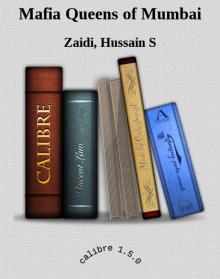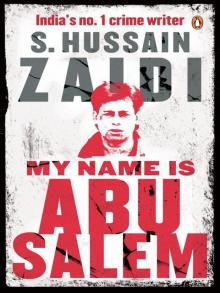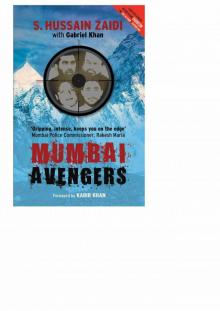- Home
- S. Hussain Zaidi
Dongri to Dubai - Six Decades of the Mumbai Mafia
Dongri to Dubai - Six Decades of the Mumbai Mafia Read online
OTHER LOTUS TITLES
Ajit Bhattacharjea Sheikh Mohammad Abdullah: Tragic Hero of Kashmir
Anil Dharker Icons: Men & Women Who Shaped Today’s India
Aitzaz Ahsan The Indus Saga: The Making of Pakistan
Alam Srinivas & TR Vivek IPL: The Inside Story
Amarinder Singh The Last Sunset: The Rise & Fall of the Lahore Durbar
Amir Mir The True Face of Jehadis:
Inside Pakistan’s Terror Networks
Ashok Mitra The Starkness of It
H.L.O. Garrett The Trial of Bahadur Shah Zafar
Kiran Maitra Marxism in India: From Decline to Debacle
Kuldip Nayar Beyond the Lines: An Autobiography
L.S. Rathore The Regal Patriot: The Maharaja Ganga Singh of Bikaner
M.B. Naqvi Pakistan at Knife’s Edge
M.J. Akbar Byline
M.J. Akbar Blood Brothers: A Family Saga
Maj. Gen. Ian Cardozo Param Vir: Our Heroes in Battle
Maj. Gen. Ian Cardozo The Sinking of INS Khukri: What Happened in 1971
Madhu Trehan Tehelka as Metaphor
Masood Hyder October Coup: A Memoir of the Struggle for Hyderabad
Nayantara Sahgal (ed.) Before Freedom: Nehru’s Letters to His Sister
Nilima Lambah A Life Across Three Continents
Peter Church Added Value: The Life Stories of Indian Business Leaders
Sharmishta Gooptu
and Boria Majumdar (eds) Revisiting 1857: Myth, Memory, History
Shashi Joshi The Last Durbar
Shashi Tharoor &
Shaharyar M. Khan Shadows Across the Playing Field
Shrabani Basu Spy Princess: The Life of Noor Inayat Khan
Shyam Bhatia Goodbye Shahzadi: A Political Biography
Vir Sanghvi Men of Steel: Indian Business Leaders in Candid Conversations
FORTHCOMING TITLES
Imtiaz Gul Osama: Pakistan Before and After
Lotus Collection
© S. Hussain Zaidi, 2012
All rights reserved. No part of the publication
may be reproduced or transmitted, in any
form or by any means, without the prior permission
of the publisher.
First published in April 2012
Fifth impression, July 2012
The views and opinions expressed in this book are the author’s own and
the facts are as reported by him which have been verified to the extent
possible, and the publishers are not in any way liable for the same.
The Lotus Collection
An imprint of
Roli Books Pvt. Ltd
M-75, Greater Kailash II Market
New Delhi 110 048
Phone: ++91 (011) 4068 2000
Fax: ++91 (011) 2921 7185
E-mail: [email protected]; Website: www.rolibooks.com
Also at Bangalore, Chennai, & Mumbai
Layout: Sanjeev Mathpal
Production: Shaji Sahadevan
ISBN: 978-81-7436-894-2
Typeset in Perpetua by Roli Books Pvt. Ltd
and printed at Nutech Printers, Okhla
Dedicated to my friends
Dr Shabeeb Rizvi
Chandramohan Puppala
Mir Rizwan Ali
Contents
Foreword
Preface
Introduction: Up, Close, and Personal
Part 1
1. The Big D
2. In the Beginning: Bombay 1950–1960
3. Bombay’s Midas
4. Madrasi Mobster
5. Tamil Alliance
6. Pathan Power
7. The Original Don: Baashu
8. The Star called David
9. The Baap of Dons
10. Of Young Turks
11. David versus Goliath
12. The First Blood
13. A Seed is Sown
14. Beginning of the Bloodshed
15. The Executioner
16. The Emergency
17. Mill Worker-Turned-Don
18. Pathan Menace
19. Mastan’s Masterstroke: The Truce
20. Dawood’s Smuggling Business
21. A Don in Love
22. Ageing Dons
23. Death of a Brother; Birth of a Gang War
24. Dawood’s Coronation
25. Mumbai’s Hadley Chase
26. The Fallout
27. Mafia’s Bollywood Debut
28. Pathan in Patharwali Building
29. Typewriter Thief: Rajan Nair
30. Pardesi Kills Pathan
31. Circle of Revenge
32. Rise of Chhota Rajan
33. Enfant Terrible: Samad Khan
34. Dawood’s Better Half
35. Escape to Dubai
Part 2
1. Making of an Empire
2. Wiping Out Rivals
3. Mafia’s Most Daring Operation
4. End of Dawood-Gawli Alliance
5. Shootout at Lokhandwala
6. JJ Shootout
7. Communal Strokes
8. Surrender Offer
9. Maal, Moll, or Mole?
10. Developments in Dubai
11. New D Company-HQ: Karachi, New CEO: Shakeel
12. Rise of the Minions
13. Shocking Bollywood
14. Peanuts That Proved Costly
15. Clandestine Coups
16. Tech That
17. Close Shave
18. The Art of Survival
19. Post 9/11
20. Not so Chori Chori Chupke Chupke
21. ‘Judge’ Dawood
22. Carnival of Spies
23. Detained in Lisbon
24. The White Kaskar
25. Global Terrorist
26. Salem Extradition
27. Boucher’s Botched Attempt
28. The Big D Makes the Forbes Cut
Epilogue
Sources
Index
Acknowledgements
Foreword
Ifirst met S. Hussain Zaidi in the winter of 1997, when I had just begun writing a novel about the Mumbai underworld. I desperately needed help, and was lucky enough to have a sister who knew Hussain through their shared profession of journalism. So I met up with him at the cheerfully-named Bahar restaurant in the Fort area of Mumbai. I asked questions, and Hussain told me stories about greed and corruption, about shooters and their targets, and despite the chill that passed over my skin, I was aware of a rising swell of optimism—this guy was really, really good.
I didn’t know that day that S. Hussain Zaidi would become a friend, an extraordinary inside informant about matters relating to crime and punishment, and my guide into the underworld. But that is exactly what happened. Over the next few years, as I wrote my novel, Hussain generously shared with me his vast knowledge, his canny experience, and his host of contacts. I can say with certainty that I would not have been able to write my book without his ever-ready help and advice.
It makes me very happy that Hussain has finished his magnum opus, Dongri to Dubai, so that the general reader can now benefit from his expertise. This book does much more than narrate the saga of one man’s rise, it brings alive the entire culture of crime that has grown and formed itself over the last half century in India. And as much as we like to distance ourselves by pretending that the underworld exists quite literally under us, beneath us, the truth—as Hussain shows—is that we mingle with it every day. The influence o
f organised crime reaches into the economy, our polity, and everyday life.
Yet, our knowledge of the intentions and operations of the players on all sides of the law is mostly a mixture of legend and conjecture. Our histories begin with a few names—Haji Mastan, Varadarajan, Karim Lala — imbued with dread, and continue with still others —Dawood, Chhota Rajan, Abu Salem—haloed with matinee glamour. What we have lacked is a narrative that provides both detail and perspective, that lays out the entire bloody saga of power-mongering, money, and murder. Dongri to Dubai is that necessary book, and more. It gives us an account that is vast in its scope and yet intimate in its understanding of motive and desire. Hussain moves us from the small gangs of early post-Independence India to the corporatising consolidations of the eighties and through the sanguine street wars of the nineties; we better comprehend our present, with its abiding undercurrent of terror, if we follow the tangled, stranger-than-fiction history that puts an Indian gangster in a safe-house in Karachi, with a daughter married to the son of a national celebrity, and his coffers enriched by the bootleg sales of Mumbai movies to Pakistanis.
Anthropologists like to use the phrase ‘thick description’ to describe an explanation of a behaviour that also includes and explains context, so that the behaviour becomes intelligible to an outsider. For most readers, I think, reading Dongri to Dubai will at first feel like a journey into an alien landscape with a trustworthy, experienced guide; by the end though Hussain has made us see, helped us to comprehend, and we recognise this terrain as our own world, and we understand—but don’t necessarily forgive—its inhabitants.
I am grateful for this book. The work that Hussain does is exacting and sometimes dangerous. Reporting about these deadly intrigues and the human beings caught within them is not for the faint of heart; the web stretches from your corner paan-shop to the bleak heights on which the Great Game is played, and there are many casualties. We all profit from Hussain’s intrepid investigations.
Vikram Chandra
Mumbai, December 2011
Preface
Dongri to Dubai: Six Decades of the Mumbai Mafia has been my most complex and difficult project since I took to reporting on crime way back in 1995. The biggest challenge by far has been chronicling the history of the Mumbai underworld and keeping it interesting for lay readers as well as choosing incidents that marked an epoch in the Mumbai mafia.
It was first suggested to me by a friend in 1997, when I was barely a couple of years into crime reporting, that I should try to write about the history of the Mumbai mafia; I was advised to replicate something like Joe Gould’s Secret. At the time, I had not even heard of the book; to be honest, I felt it was too colossal a responsibility for someone who was still wet behind the ears.
But having put my ear to the ground for Black Friday, I felt ready for a bigger challenge. Initially, I set out to find out why so many Muslim youngsters from Mumbai were drawn to crime. Was it the aura of Dawood Ibrahim or was it economic compulsion that drew them? That was the question with which I started. And somewhere along the way, I ended up doing what my friend had asked me to do initially.
When I set off on the story from Dongri, the metaphor was not lost on my friends. Am I guilty of linking members of a particular religion with crime? Unlike in the US, where exhaustive studies have been conducted on race and crime and their correlation, if any, there has been no serious debate or study on the causes that made Muslims prone to following a life of crime in the last fifty years.
When I say Dongri, it is not just the area that starts from Mandvi near Zakaria Masjid but from Crawford Market to the end of JJ Hospital, covering Null Bazaar, Umerkhadi, Chor Bazaar, Kamathipura, and all the interweaving cloth and retail markets and masjids.
Tracing the history of Mumbai, historian and researcher Sharada Dwivedi writes that the area was once a flatland and Dongri was a hill; there used to be a Portuguese fort here that the British took over and fortified. But before the British started reclaiming the land, the fort area was a low-lying area below the rocky heights of Dongri, which provided easy access to the sea. Muslim settlers are known to have lived in the higher lands near the present day Chakala Market, and in Dongri, from as far back as the fourteenth century.
The eastern part of Bombay1 island was predominantly Muslim dominated for a long time, and remains so even today. After the seven islands were linked, Dongri got a life of its own. The chaos around it happened gradually; with access to the markets, commerce thrived and so did the population. Traffic is a mess, the pavements have been taken over by hawkers, pedestrians spill onto the streets, and the place is always bustling with activity. To the west of Dongri is the Chor Bazaar (literally meaning ‘thieves’ market’) where you can get everything from old wardrobes discarded by Parsi households to antiques, gramophones, and other curios.
Long before Dawood changed the way Dongri is perceived today, others who had walked the hall of fame and notoriety in the Dongri area were Chinka Dada, Ibrahim Dada, Haji Mastan, Karim Lala, and Baashu Dada.
In those days, the easiest crime was to accost late night travellers and relieve them of their valuables. The art of pickpocketing was yet to be learnt and perfected. But the wielding of the shiny blade of a knife, sword, or chopper was enough to send shivers down the spine of the peace-loving residents of Bombay, as it was known back then. Every little crime was reported with flourish by the British journalists. One of them, Alfred W. Davis alias Gunman, who reported on crime for the Blitz, was a legend. A reporter who flowered under his tutelage was Usman Gani Muqaddam. Usman was known for his diligent news gathering and investigative skills. After extensive interviews with Usman Gani and other veteran crime reporters and my own research, I gathered that Dongri had always been the epicentre of crime in Mumbai.
In the first fortnight of 1947, the city witnessed a spate of crimes. the Times of India reported four incidents. On 1 January 1947, stray knife attacks were reported at Lalbaug, Agripada, and Dongri. The police arrested nine people and launched a drive to nab the culprits involved. Within days on 8 January, the Anti-Corruption Bureau seized 400 carving knives from a flat on Marine Drive but could not arrest anybody. The same day, a social worker was stabbed in Parel. B.J. Deorukhkar, a municipal councillor, was also murdered, an incident that shocked the city and raised an alarm.
Even before the cops could take a breather, there was another incident, but this time, they showed amazing alacrity. On 11 January, the police arrested two Pathans who had looted a bank within ninety minutes of the crime being committed. The robbers had entered a bank in south Bombay and decamped with the booty in a waiting car. The car, bearing the registration number BMX 1221 (they had covered the license plate on the back of the car with a red cloth) was making a getaway at full speed when a constable with the Esplanade Police Station, now known as the Azad Maidan Police Station, intercepted it and hauled them to the police station, where they were arrested. Ah, the power of the constabulary! Once upon a time, the constables were the backbone of the police force in Mumbai.
In the next couple of days, on 14 January, the police busted a gang of racketeers operating at the parcel booking office at Victoria Terminus (now called Chhatrapati Shivaji Terminus). The members of the gang would approach people and ask for money, assuring in return that their parcels would reach their destination earlier than via the usual route. Needless to say, the parcels never reached. Those arrested were identified as Nazir Abdul Kader, Sayed Bashir Nazir, and Fakhruddin Kaderbhai.
Most criminals from in and around Dongri became increasingly emboldened in their modus operandi as their crimes went undetected. Others from the area joined the fray when they realised that it was a chance to make easy money with very little chance of being caught. Thus, the boys from Dongri began making their mark in the crimedom.
But Dongri gained notoriety with Dawood Ibrahim; nobody took Dongri to Dubai like he did. This book traces the eventful jo
urney of Dawood’s predecessors, but most importantly, it follows Dawood’s trail too, the life of a boy from Dongri who made crime very fashionable; the boy from Dongri who flew out of the coop but refused to leave India behind, who took refuge in an enemy country but continue to play his games here. The boy from Dongri who became a don from Dubai.
Endnote
1 The name of the city ‘Bombay’ was changed to ‘Mumbai’ in 1995. So the city is referred to as ‘Bombay’ in the book for the time period till 1995.
Introduction: Up, Close, and Personal
In the nineties two things happened in India that changed the fortunes of the mafia in Mumbai. When I was writing about the Mumbai mafia back then, it had been a decade since Dawood had left its shores. Three years earlier Dawood had emerged as a key player in the serial blasts of Mumbai in March 1993. It was also at this time that Prime Minister P.V. Narasimha Rao woke up to release the country from the grip of the Licence Raj and ushered in the liberalisation of the Indian economy. When the Indian perestroika happened, it released a flood of economic opportunities and the first to smell the potential profit was the mafia, by then already entangled with Bollywood.
Suddenly there were so many real estate opportunities. There was talk of mill land sales. At the time, the many mills in Bombay were closing down fast, which meant that there was a whole lot of land in the real estate business to play around with. The only surviving mafia don at the time in Mumbai, Arun Gawli, spent most of his time behind bars. Ashwin Naik was absconding and Dawood was still in remote control mode in Dubai. His brother Anees Ibrahim was more active on the ground. And then there was the breakaway Abu Salem. Chhota Rajan had broken off with Dawood and anointed himself a Hindu don. Both were baying for each other’s blood and in the intermediate period were busy bumping off each other’s business associates in broad daylight. If it was the now defunct East West Airlines chief Thakiyuddin Wahid one day then it was builder Om Prakash Kukreja another day. The Mumbai police were blushing at the horrific body count. One police commissioner even recommended using hockey sticks for the public to defend itself. It was a great time to be a crime reporter.

 Dawood's Mentor
Dawood's Mentor HEADLEY AND I
HEADLEY AND I Mafia Queens of Mumbai
Mafia Queens of Mumbai Byculla to Bangkok
Byculla to Bangkok Black Friday
Black Friday The Endgame
The Endgame My Name is Abu Salem
My Name is Abu Salem Mumbai Avengers
Mumbai Avengers Dongri to Dubai - Six Decades of the Mumbai Mafia
Dongri to Dubai - Six Decades of the Mumbai Mafia Eleventh Hour
Eleventh Hour